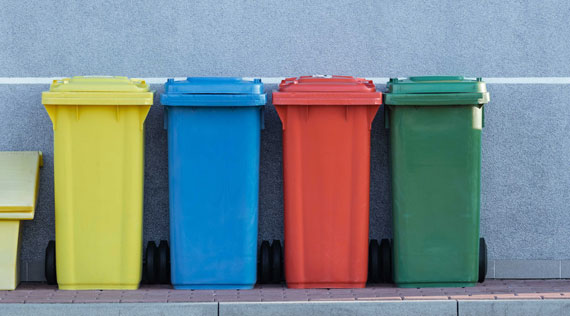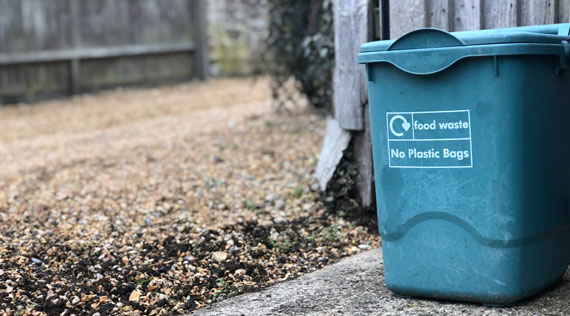When the first city in Clark County was introduced to single-stream recycling in 2012, advocates hoped for a robust program that would increase recycling rates and efficiency.
But through the years, as other cities adopted the new approach, the county’s rates failed to grow as expected.
In 2012 — the year North Las Vegas introduced single-stream recycling, in which all recyclables are placed in a single, 96-gallon cart — the county’s recycling rate was at its highest at 27.5 percent.
By 2019, the latest year for which data is available from the Nevada Division of Environmental Protection, the rate had dropped to below 20 percent.
“Single-stream recycling was never going to work,” said Steve Kalish, president and CEO of Waste Logistics Inc. “Back then, no one on the committee wanted to hear the reality that single-stream recycling wasn’t going to work.”
In 2008, Kalish sat on the Clark County Recycling Advisory Committee, which reviewed community support for and opposition to the recycling program. It also reviewed recycling rates and costs.
The recycling rates represent the percentage of discarded materials that are diverted from the landfill.
North Las Vegas was the first city in the county to approve single-stream recycling for single-family homes, followed by unincorporated Clark County and the city of Henderson in 2013, and the city of Las Vegas in 2016. By 2018, all four areas had implemented the program.
Previously, residents sorted their recyclables into small red, white and blue bins. Their trash was picked up twice a week, while their recyclables were collected every other week.
Under the new system, trash and recycling bins are picked up curbside once a week. This meant eliminating a second trash pickup each week.
“People started throwing their trash into their recycling bin since they only had one trash pickup day,” Kalish said. “Households of four or more people can’t survive off of two carts.”
Susan Brager, a former commissioner who approved the plan back in 2013, said she had hoped for a different outcome.
“I was against it at first, but then the pilot program began in my neighborhood, and I saw that it worked,” she said recently. “I knew it would be hard to monitor, but I was hopeful at the time.”
According to Rachel Lewison, Southern Nevada recycling coordinator at the Nevada Division of Environmental Protection, in 1991 the state Legislature adopted a recycling goal of 25 percent.
The most recent data from the Environmental Protection Agency shows that in 2019, Nevada had a 21.7 percent recycling rate, below the national average of 32.1 percent.
Despite Clark County’s reduced recycling rate, Jeremy Walters, the sustainability expert at Republic Services of Southern Nevada — which sorts the county’s recyclables — said he is hopeful.
“There’s always work to be done, but I believe we’re on the right track,” Walters said.
He noted that since the implementation of single-stream recycling, the company has seen a 400 percent increase in participation valley-wide. But Tara Pike, solid waste and recycling manager at UNLV, said more participation creates a higher risk of contaminated recyclables.
Contamination rate
In Southern Nevada, the contamination rate stands at 30 percent compared with the 17 percent national average, according to a Recycling Partnership 2019 State of Curbside Survey.
For example, Walters said, when people throw in a wet milk carton, that milk could spill onto clean cardboard or paper. Those items then are no longer recyclable and end up in the landfill.
When it comes to contamination rates, experts say several variables come into play.
“It comes down to education,” Lewison said.
Walters said the newness of Clark County’s recycling program, and tourists traveling into Las Vegas from areas with various recycling policies, are a couple of factors to consider.
“It’s a very transient city,” he said. “There are people visiting from different places who may not have formalized recycling programs.”
Patty Moen, Northern Nevada recycling coordinator at the Nevada Division of Environmental Protection, said people started getting confused after single-stream recycling was introduced.
“Throwing everything in your bin doesn’t mean the entire bin will get recycled and sorted through,” she said.
‘Wish-cyclers’
Experts say “wish-cycling,” also known as aspirational recycling, can affect recycling rates.
“Don’t be a ‘wish-cycler’—simply throwing an item in if you’re unsure it’s recyclable or not, hoping it’ll get recycled,” Walters said. “You’re creating more harm than good. This needs to change.”
For example, some people will throw last year’s Christmas decorations into their recycling cart and not think twice about what happens next.
“Use your imagination; we’ve seen it all,” Walters said. “There’s the bowling balls, the car parts, soccer balls, mannequins, firearms, lamps, animals and wigs, to name a few of the strangest.”
Brager said residents have grown complacent.
“We need to boost education in our community and give people a nudge about our program constantly if we want to see our rates increase,” she said.
Courtesy : https://www.reviewjournal.com/

